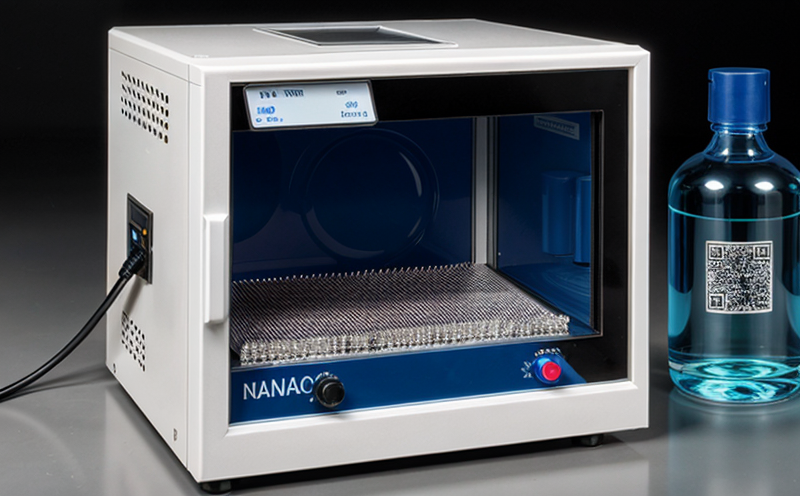DIN EN ISO 21363 Nanoparticle Sample Preparation Testing
The DIN EN ISO 21363 standard provides a robust framework for the sample preparation and testing of nanoparticles. This service is essential for ensuring that samples are accurately characterized, which is critical in various industries where nanomaterials play a significant role.
Compliance with this international standard ensures consistency and reliability across different laboratories and regions, thereby fostering trust among stakeholders. The process involves several key steps: selecting the appropriate sampling technique, preparing the sample according to ISO 21363 guidelines, and then analyzing it using advanced analytical techniques.
The importance of proper sample preparation cannot be overstated; even minor deviations can lead to inaccurate results. By adhering strictly to the specified procedures outlined in DIN EN ISO 21363, we ensure that every step is meticulously followed, leading to precise and reproducible data.
This service caters specifically to industries dealing with nanomaterials such as pharmaceuticals, electronics, and environmental science. In these sectors, the behavior of nanoparticles can significantly impact product performance and safety. Therefore, accurate characterization is paramount for research & development (R&D), manufacturing processes, and regulatory compliance.
Our team of experts uses state-of-the-art equipment calibrated to meet ISO standards. We employ a variety of methods including laser scattering techniques, transmission electron microscopy (TEM), scanning electron microscopy (SEM), and atomic force microscopy (AFM) depending on the particle size range and characteristics required by your specific application.
The goal is not only accurate measurement but also ensuring that all samples are prepared under controlled conditions to avoid contamination or alteration of properties. This meticulous approach guarantees high-quality data that can be relied upon when making critical decisions about product formulation, process optimization, and quality assurance programs.
Scope and Methodology
The scope of our DIN EN ISO 21363 nanoparticle sample preparation testing service includes all aspects related to the collection, handling, and preliminary analysis of nanomaterials. This covers everything from initial sampling through to preparation for further detailed characterization.
- Sampling Techniques: We use various methods such as filtration, centrifugation, or direct aspiration based on the nature of the sample.
- Sample Handling: Samples are stored under specific conditions to maintain their integrity until analysis can be conducted.
- Preliminary Analysis: Initial checks include visual inspection and basic measurements like weight and volume.
The methodology strictly follows DIN EN ISO 21363, which specifies detailed procedures for each stage of sample preparation. These guidelines are designed to minimize potential sources of error while maximizing the accuracy and precision of subsequent analyses.
Our laboratory adheres meticulously to these protocols using only the most precise instruments available. This ensures that every sample is treated with care and attention, resulting in reliable data that meets international standards.
Industry Applications
The application of DIN EN ISO 21363 nanoparticle sample preparation testing extends across multiple sectors where nanomaterials are integral to product development and manufacturing processes. Here, we highlight some key areas:
- Pharmaceutical Industry: Ensures the stability and efficacy of drug formulations containing nanoparticles.
- Electronics Sector: Validates the performance characteristics of electronic components made from nanomaterials.
- Environmental Science: Monitors environmental impacts caused by nanoparticle emissions or releases into natural systems.
In each case, accurate characterization is crucial for ensuring safety and effectiveness. For instance, in the pharmaceutical industry, understanding how nanoparticles interact with biological systems helps optimize drug delivery mechanisms. In electronics, knowing the exact size distribution of nanomaterials within circuits can enhance conductivity or reduce heat generation.
The environmental sector benefits from this service by providing insight into potential hazards posed by nanoparticle releases to ecosystems and public health.
Use Cases and Application Examples
- Pharmaceutical Research: Preparing samples of drug delivery systems containing nanoparticles for testing their bioavailability and toxicity.
- Electronics Manufacturing: Characterizing the surface area and morphology of nanomaterials used in semiconductors to improve performance metrics like efficiency and durability.
- Environmental Monitoring: Analyzing air or water samples for traces of nanoparticles to assess pollution levels and compliance with regulatory limits.
In addition, this service supports quality assurance programs by regularly verifying the consistency of nanomaterial properties throughout production processes. This helps maintain high standards and ensures that products consistently meet specified requirements.





